The strength of the 2024 MLB draft is the top tier of college position players, five hitters who are all legitimate candidates to go No. 1 overall on draft day.
You can also see all five of these emerging stars in action this weekend as their teams have all reached the super regional round of the NCAA baseball tournament and will be playing with hopes of leading their teams to the Men's College World Series in Omaha.
Given the data- and video-rich environment that we now have in modern college baseball, along with my own in-person looks and thoughts from evaluators around the league, we are able to take a deep dive on the important baseball traits that separate this group from the rest of this year's draft class and also break down the deciding factors that could ultimately decide which of them the Cleveland Guardians select with this July's No. 1 pick.
Starting with an SEC slugger who made NCAA home run history this season, here's a look at the players slugging their way to the top of this year's MLB draft.
![]() Mock Draft 1.0 | Ranking top 150-plus prospects
Mock Draft 1.0 | Ranking top 150-plus prospects
Charlie Condon, 3B, Georgia
Summary: Above average at everything in the batter's box, some defensive value and big power as a separator.
Excels At: Plus-plus raw power that he gets to in games, along with solid bat-to-ball ability.
Needs to Improve: Defensively at third base
Hitting grades
(50 is MLB average, graded in 5 point increments, 10 is a standard deviation)
Bat control: 55
Pitch selection: 55
Game power: 65 (about 30 homers annually)
Raw power: 70
Condon was getting Wyatt Langford comps last season because of his similar lack of hype before breaking out in college baseball's best conference (Condon redshirted as a true freshman, while Langford had four plate appearances as a true freshman at Florida) and a similar combination of simple swing mechanics and plus-plus raw power from the right side demonstrated en route to becoming a top draft prospect.
Georgia is hosting a super regional this weekend, so I wanted to remind you about the top prospect in the 2024 draft, UGA's Charlie Condon. Here's my slo-mo of a Condon HR (114 mph exit velo) from earlier this spring. pic.twitter.com/XEYu7S2Pif
— Kiley McDaniel (@kileymcd) June 6, 2024
It's not just his bat that has caught the attention of scouts either. Condon was seen as a first-base-only prospect entering the spring, which limited his draft ceiling, so evaluators were surprised early this season when he was passable in center field, solid in a corner spot and perfectly respectable at third base. His frame, tool grades and position are now reminiscent of Kris Bryant, and he's the consensus (but not unanimous) best prospect in the draft.
Now let's drill down on what he has done at the plate. First and foremost in this era of high velocity, Condon has been very good in the 114 pitches he has faced of 95-plus mph the past two seasons, with five homers and a 1.865 OPS, higher than his overall 1.463 OPS. He also has a very low overall fastball miss rate this season (10%).
His 2024 home/road splits are of note: a 1.719 OPS and 20% chase rate at home vs. a 1.296 OPS and 31% chase rate on the road, though his 2023 home/road splits were much less severe, and other hitters on this list had a similar 2024 home/road split. The more I look into this, I still don't find anything that makes me worry.
Condon's slightly better than average chase rate is the one area in which he isn't excelling, but even that is misleading. He is listed at 6-foot-6 and hits with an upright stance, standing a bit more off the plate than the average hitter. It's important to keep that in mind when looking at his heat map, with the strike zone in black outline:
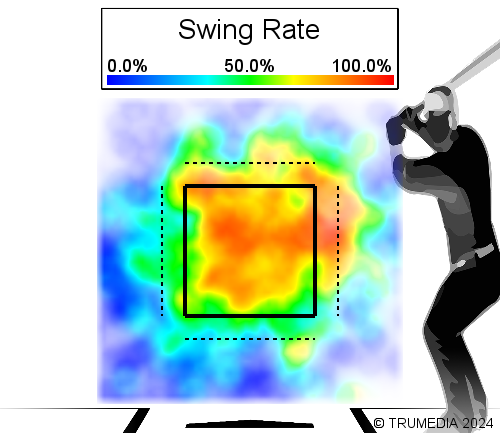
He's generally laying off the lowest strikes and borderline pitches while doing the same on the outside corner, in and out of the zone. His chases are overwhelmingly up and in. And that's where his setup -- tall, stands upright, and off the plate -- comes into play with the yellow/orange/red zones on his heat map. Something like a quarter of those swings in red/yellow/orange register as "chases" out of the strike zone even though they're in his nitro zone. Looking at his isolated power shows this with many of his extra base hits clearly coming on pitches in that same area.

So, the one part of Condon's hitting profile that isn't a plus -- his rate of chasing balls out of the zone -- just shows the limitation of that measure without diving deeper because it's mostly in an area that he's intentionally choosing to take advantage of what works for him. Condon has a pull tendency, but that's because he swings disproportionately at balls that should be pulled; his opposite-field extra-base hits are literally all on middle-to-away pitches, so he's also handling them appropriately.
For a guy with his power, long arms and loft in his swing, he doesn't really miss in the zone, and that's what makes him elite. Here are his miss rates, with much of the strike zone in blue, the lowest miss rate.

If it turns out in pro ball that he needs to cover that away pitch better, the solution could be as simple as moving a little closer to the plate. This well-rounded set of skills is truly incredible stuff from a guy who has been on the prospect radar for two seasons while many of his peers were known and facing top competition early in their high school career.
Travis Bazzana, 2B, Oregon State
Summary: Elite pitch selection and in-game power. He's pretty good at everything else, too.
Excels At: Easily plus raw power, in-game power and pitch selection while playing infield, and he runs a bit above average
Needs to improve: Bat-to-ball skill is more good than great, and his speed/defense/arm package is just all right.
Hitting grades
(50 is MLB average, graded in 5 point increments, 10 is a standard deviation)
Bat control: 50
Pitch selection: 65
Game power: 60 (about 25 homers annually)
Raw power: 60
Bazzana has had a bananas spring, keeping pace with Condon at the top of the Division I OPS leaderboard. Bazzana's huge spring has come after he missed being eligible for last year's draft because of age by just 27 days, so his jump from 11 homers last season to 28 homers this year comes with the benefit of being older than the other top college players in the draft while playing in the third-best conference in the country, the dearly departed Pac-12.
That's not to minimize how good Bazzana has been this year, though. He finished the regular season tied for the highest barrel rate (rate of balls hit at 95-plus exit velocity and 10 to 30 degrees of launch angle) and lowest chase rate (swinging at pitches outside the strike zone) among draft-eligible players in Power 5 conferences. That's an incredible combination because those are arguably the two most prized skills in player evaluation today. That he also offers some baserunning and defensive value along with solid bat-to-ball ability is just gravy. Oddly, Bazzana was better on the road than at home this year (1.608 OPS vs. 1.493 OPS, with lower chase rates on the road as well).
5 college hitters from the last 5 years have a game w/4 batted balls over 108 mph
— Kiley McDaniel (@kileymcd) February 26, 2024
Travis Bazzana 2024
Jac Caglianone 2023
Kemp Alderman 2023
Brock Wilken 2022
Spencer Jones 2022
Bazzana is the only one that plays up the middle. Other 4 have ++ raw power https://t.co/yU4nkXTo6w
The main issue keeping scouts from being all-in on Bazzana over Condon as the No. 1 prospect isn't what he did on the field this year, but more about how some might project him going forward. Using his conference, age, physical build, second-base defense that is fine but not great and below-average arm strength, some scouts will paint a picture of a player without much room to improve who could end up in left field, which would make him more of a solid big leaguer than a star. That might sound harsh -- it likely is -- but at least one of these five players I'm profiling here will likely be a bust, so scouts are forced to imagine the path for each player where unlikely things happen or consider minor negatives that have ballooned into bigger problems for other similar players.
On the other hand, Bazzana has the kind of skills that will likely move him through the minors quickly and won't require him to rework his swing or change what he's doing in a major way. That he's this polished without having the conventional American showcase circuit reps is remarkable, serving to undercut the negative of his age vs. his peers. Bazzana also has a very advanced understanding of his swing and metrics and is constantly working to improve -- which some scouts would argue is the most important mental ability to have -- while excelling at the two most important hitting abilities. If you get talked out of Bazzana by some of the above, you still have to be prepared to see him in the big leagues as soon as next season doing stuff like this:
Intro the construction zone and the Pac-12 Player of the Year has his 27th home run of the season!
— Oregon State Baseball (@BeaverBaseball) June 1, 2024
ESPN2 #GoBeavs pic.twitter.com/P55dBW6UjJ
Jac Caglianone, 1B, Florida
Summary: Two-way star with a very clear set of elite skills and weaknesses. That doesn't make him any easier to project.
Excels At: 80-grade raw power and plus bat-to-ball ability: a combined package that we haven't seen in the draft in years. He runs pretty well, too.
Needs to Improve: He's locked into a corner position, if not first base, and has the worst chase rate (swinging at balls outside the strike zone) of any early-round prospect in years.
Hitting Grades
(50 is MLB average, graded in 5 point increments, 10 is a standard deviation)
Bat control: 60
Pitch selection: 30
Game power: 65 (about 30 homers annually)
Raw power: 80
The first thing to figure out for any pro team evaluating Caglianone is how to solve his chase rate (swinging at pitches outside the strike zone). Look at Bazzana's (left) versus Caglianone's (right):
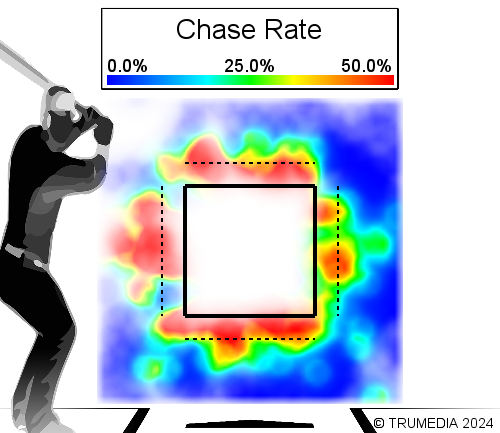

Bazzana's chase chart looks like tie-dyed art while Caglianone's looks like a heatmap from the climactic scene of Oppenheimer.
While that part is as simple as I've presented it so far, there are a few more variables to consider. Caglianone is second- or third-round talent as a left-handed pitcher, and though he likely won't play both ways early in his pro career, teams think there will be extra room for improvement at the plate when he fully focuses on being a position player. Caglianone is also a good enough athlete to play a corner-outfield spot, even though he hasn't done it much before, and he is quick enough with enough arm strength to offer some real baserunning and defensive value.
The bullish theory is that Cags has truly incomparable physical ability and that players like this are better at making adjustments when they have to, as competition gets stronger. The common take in player development circles is that bat-to-ball ability demonstrates a baseline level of "eye talent" to see the ball, make a decision and have the brain tell the hands to do something, so pitch selection is merely the discipline to act on that demonstrated ability. Thus, chase rate is the easiest thing for which to project improvement in pro ball, much more than bat-to-ball ability or bat speed/raw power.
Moving Caglianone's 40% chase rate to even Condon's 26% level isn't that realistic, though, so the reasonable position is banking on improvement rather than transformation. Is there a scenario where Caglianone is in the big leagues in three years hitting .260 with an 8% walk rate and 30ish homers while playing a solid right field? That's believable and also pretty close to what Fernando Tatis Jr. did last season while posting 4.2 WAR and painting a rosy upside picture. That said, the downside here is a slugger putting up big numbers in Triple-A who can't quite put together good enough at-bats in the big leagues to get to his power -- and then maybe starts dabbling on the mound.
Braden Montgomery, RF, Texas A&M
Summary: Has improved his contact ability this spring while also gaining power.
Excels At: 80-grade arm, 70-grade power, everything else is solid
Needs to improve: Corner outfielder with more good than great hit/on-base ability
Hitting grades
(50 is MLB average, graded in 5 point increments, 10 is a standard deviation)
Bat Control: 50
Pitch selection: 50
Game power: 65 (30ish homers annually)
Raw power: 70
I'll focus on the switch-hitting Montgomery's left-handed swing as more than a few scouts think he should drop hitting right-handed in pro ball, but it's at least a question mark because it's notably weaker than his left-handed swing and he has had notably worse outcomes this season hitting right handed.
His big swing change is reduced hand movement:
Just stop it JJ!!#HailWV pic.twitter.com/IrzYh7cxIK
— WVU Baseball (@WVUBaseball) June 3, 2024
With that limited hand movement, he is still producing 70-grade exit velocity and 70-grade BP power while hitting 26 homers with a 1.185 OPS this season. That is a truly rare physical ability. Some evaluators I spoke with think there's a happy medium where Montgomery brings back some length/depth to his hand load, but others think he already has some swing-and-miss issues with his current approach, so he should stick with something close to what has worked this season and maybe continue moving more toward contact.
Montgomery's left-handed chase chart looks more like Caglianone's than Bazzana's, which brings into focus some questions about his approach.
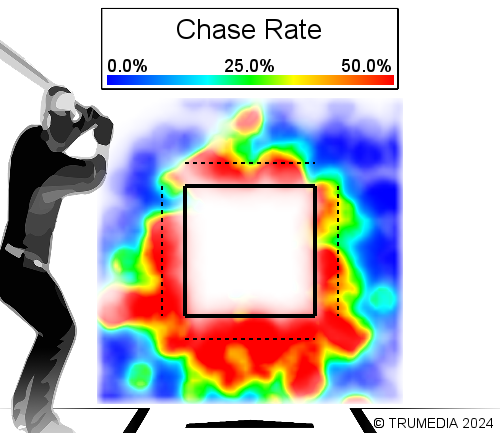
Montgomery has much higher miss rates (any kind of whiff, in or out of the zone) on changeups and curveballs than fastballs. In fact, his miss rate on pitches 85-plus mph is 18% compared to 26% on pitches below 85 mph. His changeup miss rate is 38% on 289 pitches this season. This could be a recognition issue, an approach issue or some combination of both.
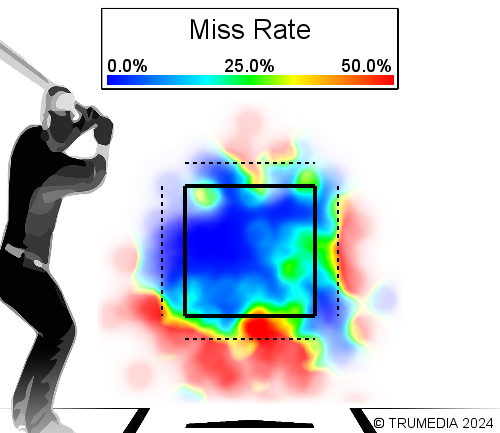
There is a lot of red just below the zone, and the actual pitches that make up that area are in large part changeups along with some backfoot sliders and only a couple fastballs. This combination of a tendency to chase in general, but specifically on soft stuff below the zone, means Montgomery will get a steady diet of this in pro ball and be forced to make adjustments to succeed.
Montgomery's game has lots of upside -- hitting 30 homers annually as a well-rounded above-average everyday right fielder who could make some All-Star teams -- but this question is big enough that some teams in the top 10 aren't really considering him for their pick.
J.J. Wetherholt, SS, West Virginia
Summary: The leading candidate for the top pick entering the spring missed time this year due to a hamstring injury and is now underrated.
Excels At: Might be plus at everything in the batter's box while also playing a passable shortstop and running better than average.
Needs to improve: He has had a couple soft tissue issues over the past two seasons, is a second baseman with limited physical projection for some and was arguably better last spring than this spring.
Hitting grades
(50 is MLB average, graded in 5-point increments, 10 is a standard deviation)
Bat control: 60
Pitch selection: 65
Game power: 55 (20ish homers annually)
Raw power: 60
Wetherholt is right there with Bazzana in posting some of the best chase rates (i.e., swing decisions) among major conferences of college baseball for two straight seasons. Wetherholt is also right there with Condon and Caglianone for the best bat control metrics among this group of hitters. His blue zone with the lowest miss rates is essentially the entire strike zone and extends to some spots outside of it, as well.
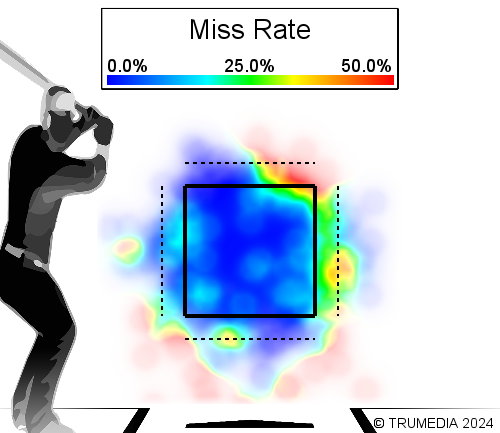
Wetherholt has above-average to plus power and good feel to get to that power in games -- let's call it 20-25 homer upside. Compared to Condon's ISO chart, which is red almost everywhere, Wetherholt's ISO chart (combining 2023 and 2024 to get a comparable sample to these other hitters because of his time missed) shows his peak damage zone is much smaller but still most of the strike zone.
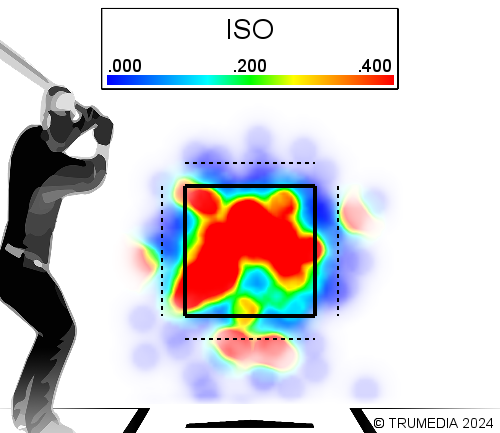
He's generally seen as a long-term second or third baseman, but he'll start his pro career at shortstop and runs a bit better than average, with enough arm to play anywhere, even if his defense isn't the silky smooth ideal of a shortstop.
Texas A&M OF Braden Montgomery has had a huge 2024: .390/.520/.915, 17 HR, 29 BB, 21 K. Bat-to-ball is real, approach is improved.
— Kiley McDaniel (@kileymcd) April 7, 2024
On Friday, he hit multiple balls out of the stadium in BP with a quiet, simple swing. He has plus-plus power but gets there w/short hand separation. pic.twitter.com/XfzPoEO6gd
Some of his draft stock will come down to what teams decide about his medicals given his two soft-tissue injuries, but Wetherholt might be the second-best player in this draft because he has the highest floor and a comparable ceiling. I can't find anything worrisome in his splits, spray charts or TrackMan data other than he was a little better last season than this year, but he also didn't miss as much time in 2023 and had the whole nonconference schedule to get him ready for conference play.
So, while Wetherholt doesn't have the traditional size, obvious physical ability or bulk 2024 performance that you typically see in a top-10 pick, he's above average at almost everything on a baseball field both in terms of physical tools and polish. "Moneyball" wasn't about J.J. Wetherholt, but it wasn't not about him.
